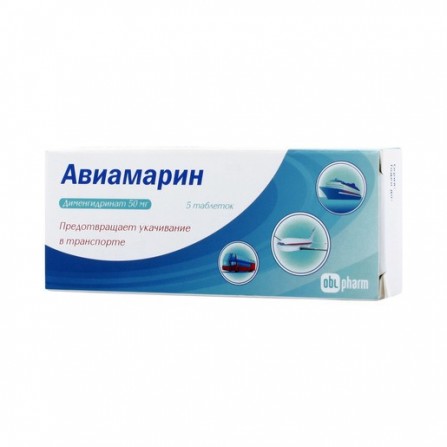More info
Active ingredients
Dimenhydrinate
Release form
Pills
Composition
Dimenhydrinate 50.0 mg; Auxiliary substances: microcrystalline cellulose 40.0 mg, povidone 4.0 mg, crospovidone 10.0 mg, mannitol 90.0 mg, colloidal silicon dioxide (aerosil) 4.0 mg, magnesium stearate 2.0 mg.
Pharmacological effect
Blocks histamine H1 receptors and m-cholinergic receptors of the central nervous system. It inhibits the vestibular apparatus of the inner ear, acting primarily on the otoliths, in high doses - on the semicircular canals. The main effect of dimenhydrinate is realized due to the blockade of m-cholinergic receptors. It has an antiemetic, sedative effect, eliminates dizziness.
Pharmacokinetics
After ingestion, dimenhydrinate is well absorbed and distributed to organs and tissues. The effect of the drug is manifested after 15-30 minutes and lasts for 3-6 hours. About 78% of dimenhydrinate binds to plasma proteins. Dimenhydrinate is metabolized in the liver and is almost completely excreted in the urine within 24 hours. Small amounts are excreted in breast milk. T1 / 2 of dimenhydrinate is about 3.5 h.
Indications
Sea and air sickness. Prevention and treatment of symptoms of vestibular and labyrinth disorders (dizziness, nausea, vomiting), with the exception of symptoms caused by antitumor therapy. Symptomatic therapy of Meniere's disease.
Contraindications
Hypersensitivity to dimenhydrinate or other components of the drug, children under 6 years old, breastfeeding period.
Use during pregnancy and lactation
The use of the drug during pregnancy is possible only if the expected benefit to the mother outweighs the potential risk to the fetus. The use of the drug during breastfeeding is contraindicated. If necessary, use of the drug, breast-feeding should be discontinued.
Dosage and administration
Inside, before eating. For the prevention of motion sickness, the first dose should be taken 30-60 minutes before the start of movement. Children aged 6-12 years: 1 / 2-1 tablet (25-50 mg) every 6-8 hours, but not more than 3 pills (150 mg) within 24 hours. Adults and children 12 years and older: 1-2 pills (50-100 mg) every 4-6 hours, but not more than 8 pills (400 mg) for 24 hours.
Side effects
The incidence of adverse reactions is as follows: very often (≥1 / 10 cases), often (≥1 / 100 and <1/10 cases), infrequently (≥1 / 1000 and <1/100 cases), rarely (≥1 / 10000 and <1/1000 cases) and very rarely (<1/10000 cases, including individual messages). From the central nervous system: very often - dizziness, drowsiness, impaired concentration of attention; often - general weakness, fatigue, anxiety, nervousness; rarely - headache, insomnia. On the part of the sense organs: often - weakening of night and color vision, blurred vision, disturbance of accommodation. On the part of the digestive system: often - dry mouth, nausea, vomiting; very rarely - loss of appetite. From the respiratory system: infrequently - dry nasal and throat mucosa, thickening of bronchial secretions. From the cardiovascular system: rarely - lowering blood pressure, tachycardia. Allergic reactions: rarely - skin rash, medical dermatitis; very rarely - angioedema, bronchospasm. From the urinary system: rarely - difficulty urinating. Other: rarely - hemolytic anemia. If any of the adverse reactions listed in the instructions are aggravated, or you notice any other undesirable effects that are not listed in the instructions, report this doctor.
Overdose
Symptoms: dry mouth, nose and throat, redness of the face, slow and difficult breathing, confusion, in children - convulsions, hallucinations. If these symptoms occur, urgently need to see a doctor. Treatment: washing the stomach with a suspension of activated carbon (20- 30 g), the appointment of a saline laxative (10-15 g of sodium sulfate), symptomatic therapy, with convulsions in children - phenobarbital (5-6 mg / kg), diazepam.
Interaction with other drugs
Dimensionalnaya the scopolamine,painkillers and psychotropic drugs increase the likelihood of visual impairment. Simultaneous use of the drug with ototoxic antibiotics (streptomycin, neomycin, viomycin, amikacin, kanamycin) is not recommended, because dimenhydrinate may mask the symptoms of ototoxicity and contribute to the development of irreversible hearing loss.
special instructions
With the use of dimenhydrinate, false-negative results of allergic tests are possible. Allergic tests should be carried out no earlier than 3 days after the end of administration of dimenhydrinate. Dimenhydrinate can show a false increase in theophylline level in the blood when it is determined by an immunological method. Dihydrogenate can mask the symptoms of ototoxicity and contribute to the development of irreversible hearing loss, and therefore it is not recommended that it be simultaneous use with ototoxic antibiotics. Diginehydrinate is metabolized in the liver, and therefore care should be taken when using the drug in Patients with hepatic impairment. Effect on the ability to drive motor vehicles and control mechanisms. Considering side effects of dimenhydrinate, care should be taken when driving and engaging in potentially hazardous activities that require increased attention and psychomotor speed.





